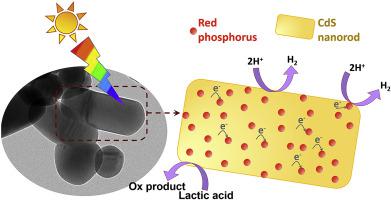International Journal of Hydrogen Energy ( IF 7.2 ) Pub Date : 2020-04-28 , DOI: 10.1016/j.ijhydene.2020.04.200 Mengying Xu , Linlin Jiang , Junting Wang , Shuying Feng , Pier-Luc Tremblay , Tian Zhang

|
The photocatalytic production of H2 by low-cost semiconductors is a promising approach to store solar energy. Photocatalysts with heterojunctions convert visible light into H2 faster because of more efficient charge separation. The morphology, the structure, and the crystallinity are additional factors to consider when developing a photocatalyst. Here, highly-crystalline CdS nanorod (NR) were synthesized by a facile one-pot process. Under visible light, pure CdS NR produced H2 2.1 times faster than conventional CdS nanoparticles (NP). CdS NR were then combined with the semiconductor red phosphorus (RPh). A CdS NR-based heterojunction photocatalyst with RPh5% had an excellent photocatalytic H2 evolution rate of 11.72 mmol g−1 h−1, which was 3.6 times higher than pure CdS NR. The apparent quantum efficiency of RPh5%/CdS NR was 19.57%. Furthermore, RPh5%/CdS NR exhibited a superior photogenerated charge separation efficiency and was stable with little photocorrosion compared to CdS NP showing the high potential of this heterojunction photocatalyst.
中文翻译:

具有高结晶度和无贵金属的红磷-CdS纳米棒的高效光催化制氢
低成本半导体光催化生产H 2是一种有前途的存储太阳能的方法。带有异质结的光催化剂由于电荷分离效率更高,因此将可见光更快地转化为H 2。形态,结构和结晶度是开发光催化剂时要考虑的其他因素。在这里,高度结晶的CdS纳米棒(NR)是通过简便的一锅法合成的。在可见光下,纯CdS NR产生的H 2速度是常规CdS纳米颗粒(NP)的2.1倍。然后将CdS NR与半导体红磷(RPh)合并。RPh 5%的CdS NR基异质结光催化剂具有优异的光催化H 2析出速率为11.72 mmol g -1 h -1,是纯CdS NR的3.6倍。RPh 5% / CdS NR的表观量子效率为19.57%。此外,与CdS NP相比,RPh 5% / CdS NR表现出优异的光生电荷分离效率,并且稳定,几乎没有光腐蚀,这表明该异质结光催化剂具有高潜力。


























 京公网安备 11010802027423号
京公网安备 11010802027423号